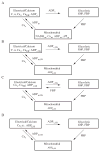Calcium and Metabolic Oscillations in Pancreatic Islets: Who's Driving the Bus?*
- PMID: 25698909
- PMCID: PMC4331037
- DOI: 10.1137/130920198
Calcium and Metabolic Oscillations in Pancreatic Islets: Who's Driving the Bus?*
Abstract
Pancreatic islets exhibit bursting oscillations in response to elevated blood glucose. These oscillations are accompanied by oscillations in the free cytosolic Ca2+ concentration (Cac ), which drives pulses of insulin secretion. Both islet Ca2+ and metabolism oscillate, but there is some debate about their interrelationship. Recent experimental data show that metabolic oscillations in some cases persist after the addition of diazoxide (Dz), which opens K(ATP) channels, hyperpolarizing β-cells and preventing Ca2+ entry and Ca2+ oscillations. Further, in some islets in which metabolic oscillations were eliminated with Dz, increasing the cytosolic Ca2+ concentration by the addition of KCl could restart the metabolic oscillations. Here we address why metabolic oscillations persist in some islets but not others, and why raising Cac restarts oscillations in some islets but not others. We answer these questions using the dual oscillator model (DOM) for pancreatic islets. The DOM can reproduce the experimental data and shows that the model supports two different mechanisms for slow metabolic oscillations, one that requires calcium oscillations and one that does not.
Keywords: calcium; dual oscillator model; metabolic; oscillations; pancreatic β-cells.
Figures









Similar articles
-
Metabolic oscillations in pancreatic islets depend on the intracellular Ca2+ level but not Ca2+ oscillations.Biophys J. 2010 Jul 7;99(1):76-84. doi: 10.1016/j.bpj.2010.04.012. Biophys J. 2010. PMID: 20655835 Free PMC article.
-
Long lasting synchronization of calcium oscillations by cholinergic stimulation in isolated pancreatic islets.Biophys J. 2008 Nov 15;95(10):4676-88. doi: 10.1529/biophysj.107.125088. Epub 2008 Aug 15. Biophys J. 2008. PMID: 18708464 Free PMC article.
-
Phase Analysis of Metabolic Oscillations and Membrane Potential in Pancreatic Islet β-Cells.Biophys J. 2016 Feb 2;110(3):691-699. doi: 10.1016/j.bpj.2015.12.029. Biophys J. 2016. PMID: 26840733 Free PMC article.
-
Electrical bursting, calcium oscillations, and synchronization of pancreatic islets.Adv Exp Med Biol. 2010;654:261-79. doi: 10.1007/978-90-481-3271-3_12. Adv Exp Med Biol. 2010. PMID: 20217502 Free PMC article. Review.
-
Control mechanisms of the oscillations of insulin secretion in vitro and in vivo.Diabetes. 2002 Feb;51 Suppl 1:S144-51. doi: 10.2337/diabetes.51.2007.s144. Diabetes. 2002. PMID: 11815474 Review.
Cited by
-
Upregulation of an inward rectifying K+ channel can rescue slow Ca2+ oscillations in K(ATP) channel deficient pancreatic islets.PLoS Comput Biol. 2017 Jul 27;13(7):e1005686. doi: 10.1371/journal.pcbi.1005686. eCollection 2017 Jul. PLoS Comput Biol. 2017. PMID: 28749940 Free PMC article.
-
A Parallel Perifusion Slide From Glass for the Functional and Morphological Analysis of Pancreatic Islets.Front Bioeng Biotechnol. 2021 Mar 5;9:615639. doi: 10.3389/fbioe.2021.615639. eCollection 2021. Front Bioeng Biotechnol. 2021. PMID: 33763408 Free PMC article.
-
Ca2+ Effects on ATP Production and Consumption Have Regulatory Roles on Oscillatory Islet Activity.Biophys J. 2016 Feb 2;110(3):733-742. doi: 10.1016/j.bpj.2015.11.3526. Biophys J. 2016. PMID: 26840737 Free PMC article.
-
Mathematical Modelling of Endocrine Systems.Trends Endocrinol Metab. 2019 Apr;30(4):244-257. doi: 10.1016/j.tem.2019.01.008. Epub 2019 Feb 21. Trends Endocrinol Metab. 2019. PMID: 30799185 Free PMC article. Review.
-
Harnessing conserved signaling and metabolic pathways to enhance the maturation of functional engineered tissues.NPJ Regen Med. 2022 Sep 3;7(1):44. doi: 10.1038/s41536-022-00246-3. NPJ Regen Med. 2022. PMID: 36057642 Free PMC article. Review.
References
-
- Ainscow EK, Rutter GA. Glucose-stimulated oscillations in free cytosolic ATP concentration imaged in single islet β-cells. Diabetes. 2002;51:S162–S170. - PubMed
-
- Bergstein RM. Slow and fast oscillations of cytosolic Ca2+ correspond to pulsatile insulin release. Am J Physiol. 1995;268:E282–E287. - PubMed
-
- Bergsten P, Westerlund J, Liss P, Carlsson PO. Primary in vivo oscillations of metabolism in the pancreas. Diabetes. 2002;51:699–703. - PubMed
-
- Bertram R, Pedersen MG, Luciani DS, Sherman A. A simplified model for mitochondrial ATP production. J Theor Biol. 2006;243:575–586. - PubMed
Grants and funding
LinkOut - more resources
Full Text Sources
Other Literature Sources
Miscellaneous
